
For this task, students solve problems involving ratios of speeds.
- Subject:
- Mathematics
- Material Type:
- Activity/Lab
- Provider:
- NRICH
- Date Added:
- 03/23/2017

For this task, students solve problems involving ratios of speeds.
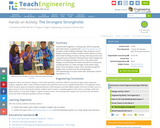
Students work together in small groups, while competing with other teams, to explore the engineering design process through a tower building challenge. They are given a set of design constraints and then conduct online research to learn basic tower-building concepts. During a two-day process and using only tape and plastic drinking straws, teams design and build the strongest possible structure. They refine their designs, incorporating information learned from testing and competing teams, to create stronger straw towers using fewer resources (fewer straws). They calculate strength-to-weight ratios to determine the winning design.
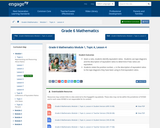
In this lesson, students are given a ratio, students identify equivalent ratios. Students use tape diagrams and the description of equivalent ratios to determine if two ratios are equivalent. Students relate the positive number, c, in the description of equivalent ratios to the tape diagrams they have been using to find equivalent ratios.
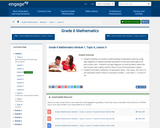
In this lesson, students develop an intuitive understanding of equivalent ratios by using tape diagrams to explore possible quantities of each part when given the part-to-part ratio. Students use tape diagrams to solve problems when the part-to-part ratio is given and the value of one of the quantities is given. Students also formalize a definition of equivalent ratios: Two ratios, A:B and C:D, are equivalent ratios if there is a positive number, c, such that C = cA and D = cB.
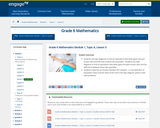
In this lesson, students use tape diagrams to find an equivalent ratio when given the part-to-part ratio and the total of those two quantities. Students use tape diagrams to find an equivalent ratio when given the part-to-part ratio and the difference between those two quantities. Students make the connection between the constant, c, in the definition of equivalent ratios and the value of the unit in the tape diagram used to solve ratio problems.
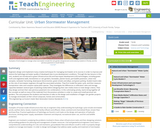
Engineers design and implement many creative techniques for managing stormwater at its sources in order to improve and restore the hydrology and water quality of developed sites to pre-development conditions. Through the two lessons in this unit, students are introduced to green infrastructure (GI) and low-impact development (LID) technologies, including green roofs and vegetative walls, bioretention or rain gardens, bioswales, planter boxes, permeable pavement, urban tree canopies, rainwater harvesting, downspout disconnection, green streets and alleys, and green parking. Student teams take on the role of stormwater engineers through five associated activities. They first model the water cycle, and then measure transpiration rates and compare native plant species. They investigate the differences in infiltration rates and storage capacities between several types of planting media before designing their own media mixes to meet design criteria. Then they design and test their own pervious pavement mix combinations. In the culminating activity, teams bring together all the concepts as well as many of the materials from the previous activities in order to create and install personal rain gardens. The unit prepares the students and teachers to take on the design and installation of bigger rain garden projects to manage stormwater at their school campuses, homes and communities.

In this lesson, students demonstrate their understanding of describing a ratio relationship between two quantities, compare ratios expressed in different ways, and use proportional reasoning to solve a real-world problem.

This unit on ratio and proportional understanding will be taught over the course of three weeks. This unit is to provide students with a thorough understanding of ratios and proportions, because they are used so much in everyday life applications and they are a natural extension after students understand the basics of fractions. First, the unit covers thoroughly the concept of ratio, including how it connects with fractions. Next, the unit focuses on equivalent ratios, because those will lead students into proportions just a few lessons later. After the foundation has been set with ratios and rates, students will make connections with proportions. Students will solve proportions by thinking through equivalent ratios and with cross-multiplying. Following this, there is more practice with solving proportions and word problems.
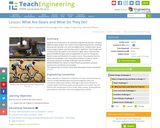
Students are introduced to an important engineering element the gear. Different types of gears are used in many engineering devices, including wind-up toys, bicycles, cars and non-digital clocks. Students learn about various types of gears and how they work in machines. They handle and combine LEGO spur gears as an exercise in gear ratios. They see how gears and different gear train arrangements are used to change the speed, torque and direction of a power source. This prepares them to apply this knowledge in four associated activities in order to create successful solutions to design challenges that use LEGO MINDSTORMS(TM) NXT robots. A PowerPoint® presentation, pre/post quizzes and a worksheet are provided.

Students learn about the definition of heat as a form of energy and how it exists in everyday life. They learn about the three types of heat transfer conduction, convection and radiation as well as the connection between heat and insulation. Their learning is aided by teacher-led class demonstrations on thermal energy and conduction. A PowerPoint® presentation and quiz are provided. This prepares students for the associated activity in which they experiment with and measure what they learned in the lesson by designing and testing insulated bottles.